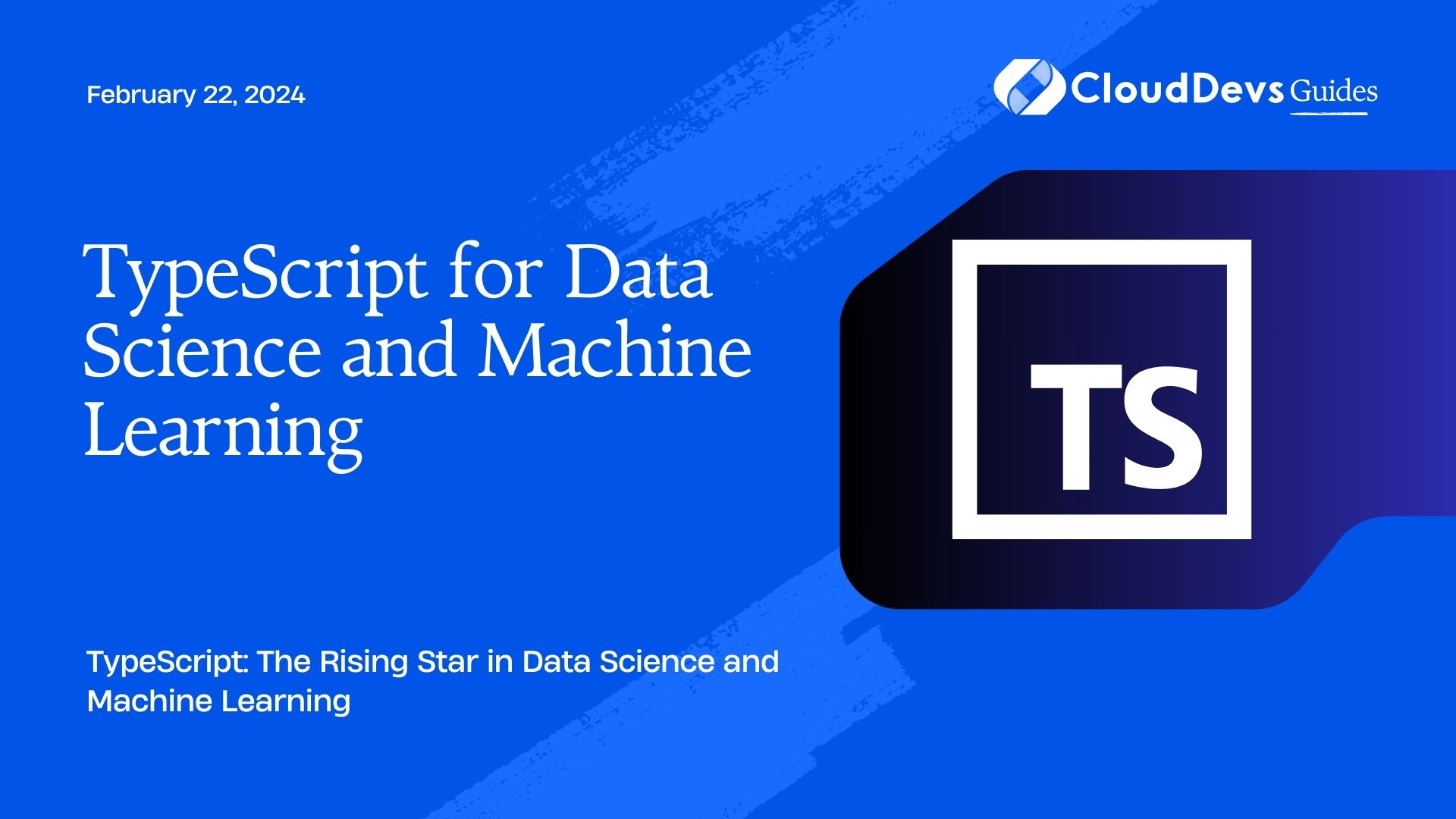TypeScript for Data Science and Machine Learning
In the ever-evolving landscape of data science and machine learning, programming languages play a pivotal role. Traditionally, Python has been the go-to language for these domains due to its simplicity, versatility, and an abundance of libraries. However, TypeScript, primarily known for its stronghold in web development, is making significant inroads into the data science and machine learning realms. In this comprehensive guide, we’ll explore how TypeScript can benefit data scientists and machine learning engineers, diving into type safety, libraries, and practical examples.
Table of Contents
1. Why TypeScript for Data Science and Machine Learning?
1.1. Type Safety in Data Science
One of TypeScript’s standout features is its strong type system. In the realm of data science, where data integrity is paramount, TypeScript’s type safety can be a game-changer. When you define types for your data structures, functions, and variables, you catch potential bugs at compile-time rather than runtime. This reduces the likelihood of runtime errors, making your data science code more reliable.
Here’s a simple example of TypeScript’s type safety in action:
typescript
function add(a: number, b: number): number {
return a + b;
}
const result = add(5, '10'); // Error: Argument of type '"10"' is not assignable to parameter of type 'number'.
In this example, TypeScript catches the type mismatch error at compile-time, preventing the code from even running. This level of safety can be a lifesaver when working with large datasets and complex algorithms.
1.2. Integrating TypeScript with Popular Data Science Libraries
Python’s dominance in data science is partially due to its rich ecosystem of libraries such as NumPy, pandas, and scikit-learn. Fortunately, TypeScript offers ways to leverage these libraries through transpilation or wrappers.
1.2.1 Transpilation to JavaScript
TypeScript code can be transpiled to JavaScript, allowing you to use existing Python libraries seamlessly. Tools like Babel and Webpack can help with this process. For instance, you can write your data preprocessing code in TypeScript and use TensorFlow.js for machine learning.
typescript import * as tf from '@tensorflow/tfjs-node'; const model = tf.sequential(); // Build and train your model...
1.2.2 TypeScript Wrappers for Python Libraries
Another approach is to use TypeScript wrappers for popular Python libraries. These wrappers provide TypeScript-compatible interfaces to Python libraries, making it easier to work with them.
typescript import * as np from 'numpy-ts'; const array = np.array([1, 2, 3, 4, 5]); const sum = np.sum(array);
1.3. Building Data Science and ML Tools
Data scientists often need to build tools and applications to visualize data or showcase machine learning models. TypeScript’s ecosystem includes powerful frontend frameworks like React and data visualization libraries like D3.js. By combining TypeScript with these tools, you can create robust web applications for data exploration and model deployment.
2. Practical Examples
To demonstrate TypeScript’s relevance in data science and machine learning, let’s explore some practical examples.
2.1. Data Preprocessing with TypeScript
In this example, we’ll use TypeScript to preprocess a dataset. We’ll define types for our data structures to ensure data integrity.
typescript
interface DataPoint {
x: number;
y: number;
}
function preprocessData(data: DataPoint[]): DataPoint[] {
// Perform data cleaning, transformation, and validation here
return data;
}
const rawData: DataPoint[] = [
{ x: 1, y: 2 },
{ x: 2, y: 4 },
{ x: 3, y: 6 },
];
const cleanedData = preprocessData(rawData);
By enforcing data types, we reduce the risk of processing incorrect data.
2.2. Linear Regression in TypeScript
Let’s implement a simple linear regression model using TensorFlow.js in TypeScript.
typescript
import * as tf from '@tensorflow/tfjs-node';
// Define the model
const model = tf.sequential();
model.add(tf.layers.dense({ units: 1, inputShape: [1] }));
// Compile the model
model.compile({ loss: 'meanSquaredError', optimizer: 'sgd' });
// Prepare the training data
const xs = tf.tensor2d([1, 2, 3, 4], [4, 1]);
const ys = tf.tensor2d([2, 4, 6, 8], [4, 1]);
// Train the model
model.fit(xs, ys, { epochs: 100 }).then(() => {
// Make predictions
const result = model.predict(tf.tensor2d([5], [1, 1])) as tf.Tensor;
console.log(`Predicted value for x=5: ${result.dataSync()[0]}`);
});
This TypeScript code leverages TensorFlow.js to create a linear regression model for predicting values.
3. TypeScript vs. Python for Data Science and Machine Learning
While TypeScript has its advantages, it’s essential to consider its pros and cons when compared to Python in the context of data science and machine learning.
3.1. Advantages of TypeScript:
- Type Safety: TypeScript’s strong type system reduces runtime errors, enhancing code reliability.
- Web Integration: TypeScript seamlessly integrates with web technologies, making it suitable for building data science dashboards and interactive applications.
- JavaScript Ecosystem: TypeScript leverages the vast JavaScript ecosystem, allowing you to use existing libraries and tools.
3.2. Advantages of Python:
- Rich Data Science Libraries: Python boasts a wide range of specialized libraries for data manipulation, analysis, and machine learning.
- Community Support: Python has a large and active data science and machine learning community, offering extensive resources and tutorials.
- Legacy Codebase: Many existing data science projects and libraries are written in Python, making it the default choice for many.
Ultimately, the choice between TypeScript and Python depends on your specific use case and requirements. You may even find value in using both languages within a project.
Conclusion
As the fields of data science and machine learning continue to evolve, so do the tools and languages available to practitioners. TypeScript, with its type safety, versatile ecosystem, and web integration, is proving to be a valuable addition to the toolbox of data scientists and machine learning engineers. Whether you’re working on data preprocessing, building machine learning models, or creating interactive data visualization applications, TypeScript can enhance your workflow and improve code reliability. Consider incorporating TypeScript into your data science and machine learning projects to leverage its strengths and stay at the forefront of these dynamic fields.
Table of Contents









